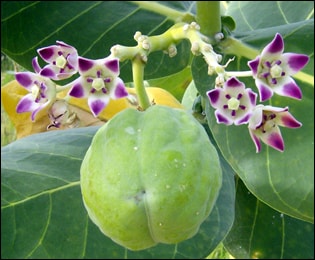Aak, Madar (Calotropis gigantea) – Uses, Benefits, Dosage and Properties

Arka (Calotropis gigantea) is a perennial shrub growing 2.5 meter high with various branches and sub branches. Leaves are simple, opposite, sub sessile, ovate and cordate at base. It has bunch of waxy flowers that are white or lavender in color. Flowers consists of pointed five petals and a small beautiful crown, which holds the stamen. It has milky stem and contains cardiac glycosides, fatty acid and calcium oxalate.
General Information of Aak
Aak (Calotropis gigantea) is known as “Arka” in Sanskrit. When we talk about the medicinal properties of this herb, it is mostly addressed with the name of Arka. Aak is a common Hindi name given to this plant which is familiar to the Indians as a perennial bush growing almost anywhere in the wild.
The tender light green stems of this plant when broken yield milky white exudates which is sticky and the plant is popular amongst the common population merely because of this peculiarity. This milky exudate is mildly poisonous and is considered as one of the plant toxins in Ayurveda. Though toxic, this exudate (latex) can be purified and put to use as a very effective antidote as well as herbal medicine.
The name of this Aak plant is synonymous with Sun for the herb is very strong and astringent in action much like the powerful rays of Sun. It belongs to the “Apocynaceae” family of flowering plants.
Special Note about Madar Plant
Arka kasheera – Latex of arka plant is capable of vomiting and purgation. It is used in purgation and vomiting therapy.
Classification
- Kingdom – Plantae
- Order- Gentianales
- Family – Apocynaceae
Habitat
This species of Calotropis is native to India, Cambodia, Indonesia, Malaysia, Phillippines, Thailand, Sri Lanka, China, Pakistan and Nepal.
Other Names of Aak
- Aak English name – Sodom apple, Apple of Sodom, Kapok tree, Rubber bush or Rubber tree.
- Aak Hindi name – Aak, Madar, Akvana
- Aak Sanskrit name – Arka, Toolaphala, Vikirana, Asfota, Alarka etc.
- Aak Punjabi name – Ak
- Aak Telugu name – Jilledu, Mandaram
- Aak Bengali name – Aaknad
- Aak Arab name – Ushar
- Aak Persian name – Kharak
- Aak Malyalam name – Neela Eukku
Ayurvedic Properties of Aak
| Hindi / Sanskrit | English | ||
| Rasa | Katu, Tikta | Taste | Pungent, Bitter |
| Guna | Laghu, Ruksha, Tikshna | Physical Property | Light, Dry, Sharp |
| Virya | Ushna | Potency | Hot |
| Vipaka | Katu | Metabolic Property (After Digestion) | Pungent |
Aak Effects on Doshas
Because of its ushna veerya it balances vata and kapha dosha. Red type flowers has (bitter and sweet taste) and used to balance pitta dosha.
| Charak Samhita | Sushrut Samhita |
| Bhedniya – Herbs which Relieve pain. | Arkadi, Adhobhaghara |
| Vamnopaga – Herbs which are used in vomiting therapy | |
| Swedopaga – Herbs used in swedan therapy. |
Vagbhata also describes this herb under Arkadi gana and following two types are explained:-
- Shweta Arka
- Shukla Arka
Rajnighantu – Describe this herb under
Kharjughana – Kerbs used to cure itching.
Ancient Verse of this Herb



- Above mentioned first shaloka explains the name and effects of white and red arka. Shuklaarka (Shweta arka)- ganroop, mandaar, vasuk, shwetpushp, sadapushp, alark and pratpas are the various synonyms of shweta arka.
- Rakta arka – arkparn, vikiran, raktpushp, shukalfal, and asfot are the various synonyms of Rakta arka. Both are used to cure vomiting, purgation, vata roga, leprosy, itching, snake bites, wounds, splenomegaly, abdominal tumors, piles, cough, ascites and intestinal worm infestation.
- Second shalok explains the properties of both types. White arka is aphrodisiac (virshya), light (laghu) in nature and stimulates digestive system (deepana and pachana). It is used to cure anorexia, excessive salvation, piles, cough and asthma. On the other hand red arka is sweet and little bit bitter in taste. It is useful in diarrhea, abdominal tumors and inflammation. It is also useful in skin disorders, worm infestation, cough, haemorroids, and bleeding disorders.
- Third shalok explains the properties of milk of arka (arka kasheera). It is salted and bitter in taste, having hot potency, light and oily in nature. It is best used to cure skin disorders, abdominal tumors and various disorders associated with abdomen. It is a best purgative and is used in purgation therapy.
Calotropis gigantea Medicinal uses
- Different parts of this plant have different medicinal properties.
- The latex obtained from the plant is used to induce vomiting as well as purgation.
- Astringent action of the herb makes it beneficial for the treatment of many skin diseases.
- Due to its vata pacifying properties, it helps in relieving bloating, flatulence and abdominal distension as a result of improper digestion of food.
- It is also effective in treating ascites in which there can be large abdominal distension due to the accumulation of fluid in the abdominal region.
- Arka has an anti-inflammatory effect on the body. Its natural cleansing and astringent action helps in early wound healing, itching, healing skin and spleen disorders.
- Because of its strong purgative action, arka helps in clearing out the intestines off any worm infestations in the body.
- Aak is a digestive stimulant which eases out the digestive process making each and every organ function smoothly.
- It improves appetite thereby fighting anorexia and disinterest in consuming food.
- Local application of this herb is very popularly used in Ayurvedic treatment practices to treat hemorrhoids. It helps in shrinking hemorrhoid tags with its strong alkaline action.
- As a kapha pacifying herb, it helps in healthy working of the respiratory system, helping in diseases like common cold, cough, asthma and other similar respiratory problems.
- The leaves and latex of Calotropis gigantea are used as an antidote for snake poison.
- “Arka lavana” prepared by processing leaves of Arka with salt is used as a very effective herbal combination for gastritis.
- Latex is good for treating diarrhea as well.
- Arka pacifies vata and kapha dosha
A Word of Caution – Side effects of Arka
- The dosage of different parts of this herb should be carefully modulated as over dosage can induce severe vomiting and diarrhea in patients.
- It should not be used during pregnancy and lactation period.
- It should not be given to children.
Ayurvedic Products from Calotropis gigantea
- Arkadi ghrita
- Arkadi kashaya
- Asanadi kashaya
Dosage
- Root bark powder – 0.5-1 g.
- Flower powder – 1-2 g.
- Leave juice – 1-4 drops
Part Used
- Aak Leaves
- Aak Latex
- Aak Root
- Aak Flowers



